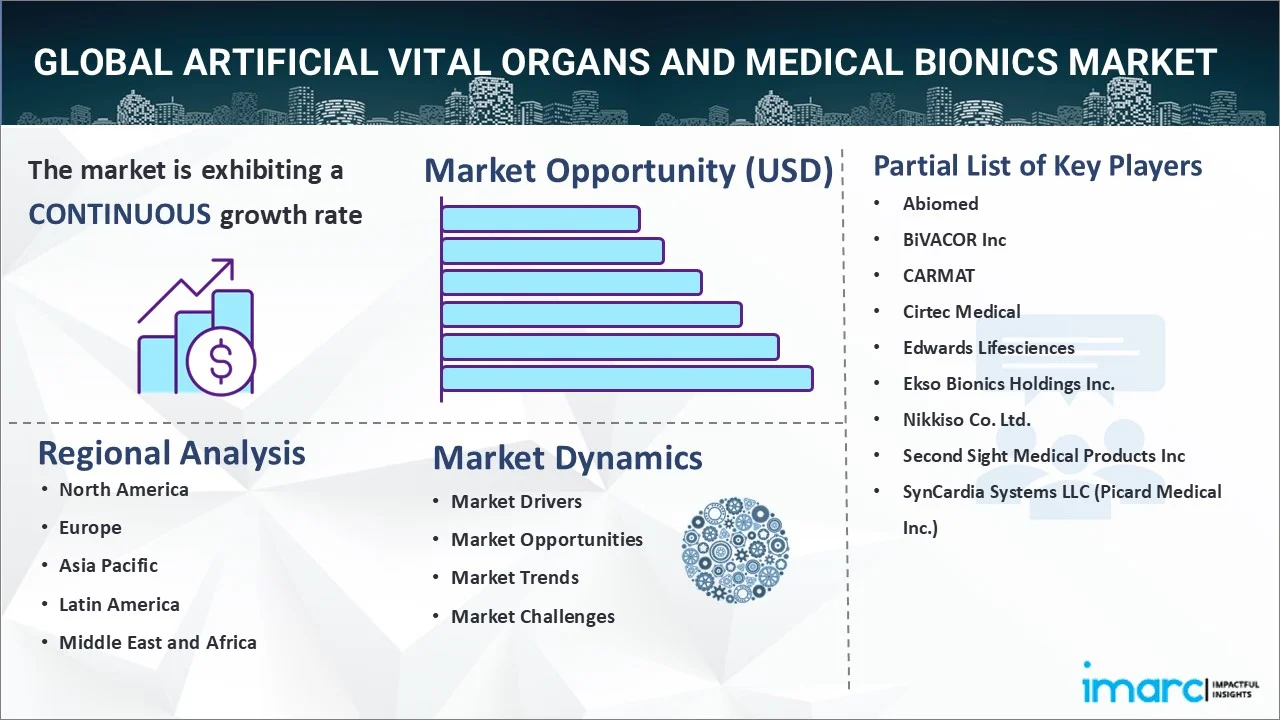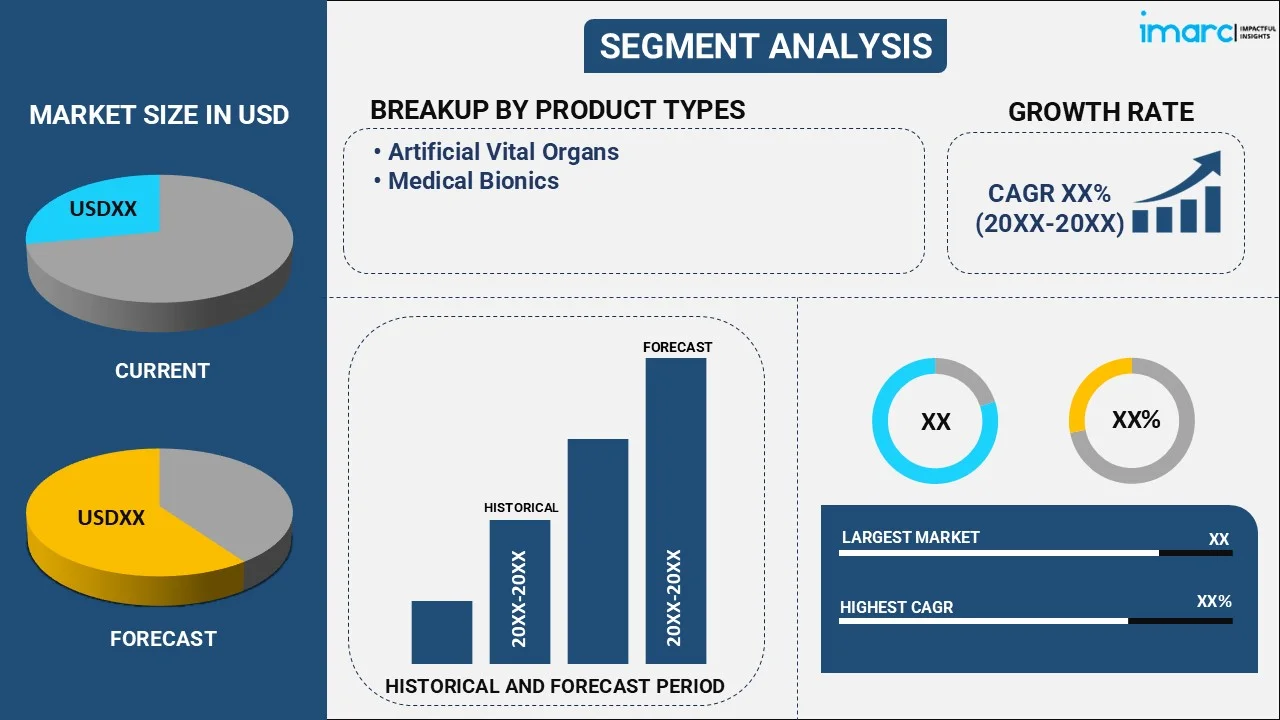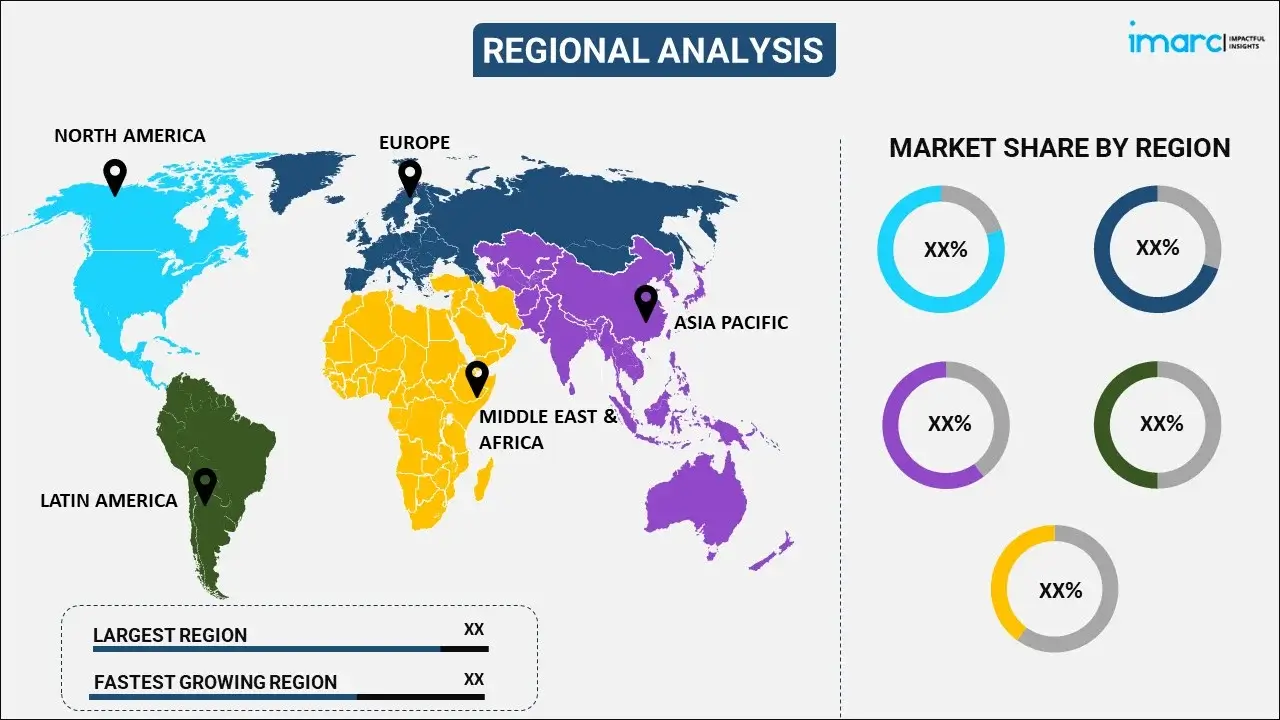
Artificial Vital Organs and Medical Bionics Market Report by Product Type (Artificial Vital Organs, Medical Bionics), Application (Hospitals, Clinics, and Others), and Region 2025-2033
Market Overview:
The global artificial vital organs and medical bionics market size reached USD 49.2 Billion in 2024. Looking forward, IMARC Group expects the market to reach USD 74.5 Billion by 2033, exhibiting a growth rate (CAGR) of 4.48% during 2025-2033. The rising prevalence of respiratory ailments, cirrhosis, and heart and liver failures, the increasing geriatric population that is highly prone to organ disorders, and various technological advancements represent some of the key factors driving the market.
|
Report Attribute
|
Key Statistics
|
|---|---|
|
Base Year
|
2024 |
|
Forecast Years
|
2025-2033
|
|
Historical Years
|
2019-2024
|
| Market Size in 2024 | USD 49.2 Billion |
| Market Forecast in 2033 | USD 74.5 Billion |
| Market Growth Rate (2025-2033) | 4.48% |
Artificial vital organs, often referred to as artificial organs or bioartificial organs, are man-made devices designed to mimic the functions of natural organs within the human body. These devices are developed to serve as temporary or permanent replacements for malfunctioning or failed biological organs, helping patients maintain essential bodily functions and, in some cases, even enhancing them. On the other hand, medical bionics is a field of medical science and engineering that focuses on the development and integration of biological and artificial components to restore or enhance the functioning of the human body.

Currently, there is a notable surge in the prevalence of various medical conditions, including respiratory disorders, cirrhosis, as well as heart, kidney, and liver failures. This surge is closely tied to the expanding healthcare sector and serves as a significant catalyst for market growth. Furthermore, the increasing elderly population, which is particularly susceptible to organ-related ailments worldwide, is making a substantial contribution to the market's expansion. Moreover, the continuous development of innovative products, such as fully functional artificial hearts, livers, lungs, urethras, windpipes, and kidneys, is exerting a positive impact on market dynamics. Additionally, major market players are making substantial investments in research and development (R&D) endeavors, aimed at introducing cutting-edge methods of organ regeneration through engineered tissues. This ongoing innovation is fostering a promising outlook for the market. Besides this, there is a rising demand for artificial organs, driven by the emergence of bioartificial organs that offer improved survival rates and faster patient recovery. This growing demand is further propelled by the implementation of life-saving technologies like the bridge to transplant and the bridge to recovery in critical medical cases, further reinforcing market growth.
Artificial Vital Organs and Medical Bionics Market Trends/Drivers:
Rising prevalence of respiratory ailments, cirrhosis, and organ failures
There has been a notable increase in the prevalence of respiratory ailments such as chronic obstructive pulmonary disease (COPD) and lung infections. Patients with severe respiratory issues often require artificial lungs or other assistive devices to breathe adequately. Moreover, liver diseases, including cirrhosis, have seen a rise due to various factors like excessive alcohol consumption, viral hepatitis infections, and non-alcoholic fatty liver disease. In advanced stages, cirrhosis may necessitate liver transplantation, and artificial livers can serve as a bridge to transplantation or even a long-term solution. Besides, heart and liver failures are significant health concerns worldwide. Conditions like congestive heart failure and end-stage liver disease are on the rise due to factors such as an aging population, obesity, and lifestyle choices. Artificial hearts and liver support systems play a crucial role in providing life-saving solutions while patients await transplantation or as a permanent support option.
Increasing geriatric population across the globe
The global demographic landscape is shifting toward an aging population. Elderly individuals are more susceptible to organ disorders due to the natural aging process, making them a key demographic for artificial vital organ interventions. Besides, the elderly population is more prone to chronic medical conditions, including cardiovascular diseases, respiratory ailments, and kidney disorders. These conditions frequently require interventions such as artificial hearts, lungs, or kidneys to manage or improve the patient's quality of life. Medical bionics, such as pacemakers and cochlear implants, are also commonly used in elderly individuals to address age-related health issues. Artificial vital organs and medical bionics become crucial in extending and improving the lives of these elderly individuals, allowing them to enjoy a better quality of life in their later years.
Various technological advancements
Advancements in medical technology have significantly improved the design, functionality, and effectiveness of artificial vital organs and medical bionics. Moreover, full-functioning artificial organs, such as artificial hearts and lungs, have been developed with enhanced capabilities, allowing patients to lead more active lives. Besides, the integration of cutting-edge materials and bioengineering techniques has led to the creation of bioartificial organs that closely mimic natural organs, reducing the risk of rejection and improving overall patient outcomes. Additionally, leading players in the medical technology industry are investing heavily in research and development activities aimed at improving artificial vital organs and medical bionics. These investments result in the development of more sophisticated devices, enhanced materials, and improved surgical techniques, all of which contribute to better patient outcomes.
Key Market Segmentation:
IMARC Group provides an analysis of the key trends in each segment of the global artificial vital organs and medical bionics market report, along with forecasts at the global, regional, and country levels from 2025-2033. Our report has categorized the market based on product type and application.
Breakup by Product Type:

- Artificial Vital Organs
- Artificial Liver
- Artificial Heart
- Artificial Pancreas
- Artificial Kidney
- Artificial Lungs
- Oxygenators
- Medical Bionics
- Bionic Limbs
- Vision Bionics
- Ear Bionics
- Exoskeletons
- Brain Bionics
- Heart Valves
- Cardiac Bionics
Artificial vital organs represent the most used product type
The report has provided a detailed breakup and analysis of the market based on the product type. This includes artificial vital organs (artificial liver, artificial heart, artificial pancreas, artificial kidney, artificial lungs, and oxygenators) and medical bionics (bionic limbs, vision bionics, ear bionics, exoskeletons, brain bionics, heart valves, and cardiac bionics). According to the report, artificial vital organs represented the largest segment.
Artificial vital organs are designed to mimic the functions of natural vital organs such as the heart, lungs, kidneys, and liver. These devices are often used as a last resort when a patient's natural organs fail. They serve a life-saving function, providing crucial support to sustain a patient's life until a transplant becomes available or the natural organs recover. Moreover, there is a consistently high demand for artificial vital organs due of the prevalence of organ failure and the limited availability of organ donors. Individuals worldwide suffer from conditions that can lead to organ failure, and the demand for replacement organs far exceeds the supply. Artificial vital organs bridge this gap by offering a viable solution to patients in critical need.
Breakup by Application:
- Hospitals
- Clinics
- Others
A detailed breakup and analysis of the market based on the application has also been provided in the report. This includes hospitals, clinics, and others.
Hospitals are a primary application for artificial vital organs and medical bionics. In these healthcare facilities, artificial vital organs such as artificial hearts, lungs, and kidneys are often used to support patients with organ failure while they await transplants. Additionally, medical bionics, including devices like cochlear implants and bionic limbs, may be provided to patients in hospital settings to improve their quality of life and functional capabilities.
Clinics, including specialized medical centers and outpatient facilities, play a crucial role in the application of artificial vital organs and medical bionics. These settings are where patients may receive diagnosis, consultation, and follow-up care related to these advanced medical technologies. Clinics often offer services related to the assessment, fitting, and maintenance of medical bionics, making them essential in the continuum of care.
Breakup by Region:

- North America
- United States
- Canada
- Asia-Pacific
- China
- Japan
- India
- South Korea
- Australia
- Indonesia
- Others
- Europe
- Germany
- France
- United Kingdom
- Italy
- Spain
- Russia
- Others
- Latin America
- Brazil
- Mexico
- Others
- Middle East and Africa
North America exhibits a clear dominance in the market
The market research report has also provided a comprehensive analysis of all the major regional markets, which include North America (the United States and Canada); Europe (Germany, France, the United Kingdom, Italy, Spain, Russia, and others); Asia Pacific (China, Japan, India, South Korea, Australia, Indonesia, and others); Latin America (Brazil, Mexico, and others); and the Middle East and Africa. According to the report, North America accounted for the largest market share.
North America, particularly the United States and Canada, boasts a highly advanced healthcare infrastructure with state-of-the-art medical facilities and research institutions. This infrastructure fosters innovation and the development of cutting-edge medical technologies, including artificial vital organs and medical bionics. Besides, the region is a global hub for medical research and development. Leading universities, medical centers, and private companies collaborate to push the boundaries of medical science. This collaborative environment accelerates the creation and commercialization of medical bionics and artificial vital organs. Moreover, the region has well-established regulatory bodies, such as the Food and Drug Administration (FDA) in the United States and Health Canada, which ensure the safety and efficacy of medical devices. A robust regulatory framework provides confidence to investors, manufacturers, and healthcare providers, encouraging the development and adoption of medical bionics.
Competitive Landscape:
The competitive landscape of the market is characterized by the presence of multiple players that include established brands, emerging startups, and specialty manufacturers. Presently, leading companies are heavily investing in R&D to develop innovative and advanced artificial vital organs and medical bionics. They focus on improving the performance, durability, and safety of these devices, as well as reducing their size and enhancing compatibility with the human body. They are also expanding their product portfolios to cover a broader range of medical bionics and artificial organs. This diversification allows them to address a wider array of medical conditions and patient needs. Besides, companies are acquiring or merging with other companies in the industry to expand capabilities, gain access to new technologies, and increase market share.
The market research report has provided a comprehensive analysis of the competitive landscape. Detailed profiles of all major companies have also been provided. Some of the key players in the market include:
- Abiomed
- BiVACOR Inc
- CARMAT
- Cirtec Medical
- Edwards Lifesciences
- Ekso Bionics Holdings Inc.
- Nikkiso Co. Ltd.
- Second Sight Medical Products Inc
- SynCardia Systems LLC (Picard Medical Inc.)
(Please note that this is only a partial list of the key players, and the complete list is provided in the report.)
Recent Developments:
- Edwards LifeSciences Corporation invested $35 million in an exclusive right to acquire Corvia Medical, Inc., the developer of the world's first transcatheter device designed to treat heart failure with preserved or mid-range ejection fraction.
- In February 2020, Ekso Bionics Holdings, Inc. teamed up with Kindred Healthcare, LLC to test EksoNR, a robotic exoskeleton, in their long-term acute care hospitals.
Artificial Vital Organs and Medical Bionics Market Report Scope:
| Report Features | Details |
|---|---|
| Base Year of the Analysis | 2024 |
| Historical Period | 2019-2024 |
| Forecast Period | 2025-2033 |
| Units | Billion USD |
| Scope of the Report | Exploration of Historical Trends and Market Outlook, Industry Catalysts and Challenges, Segment-Wise Historical and Future Market Assessment:
|
| Product Types Covered |
|
| Applications Covered | Hospitals, Clinics, Others |
| Regions Covered | Asia Pacific, Europe, North America, Latin America, Middle East and Africa |
| Countries Covered | United States, Canada, Germany, France, United Kingdom, Italy, Spain, Russia, China, Japan, India, South Korea, Australia, Indonesia, Brazil, Mexico |
| Companies Covered | Abiomed, BiVACOR Inc, CARMAT, Cirtec Medical, Edwards Lifesciences, Ekso Bionics Holdings Inc., Nikkiso Co. Ltd., Second Sight Medical Products Inc., SynCardia Systems LLC (Picard Medical Inc.), etc. |
| Customization Scope | 10% Free Customization |
| Post-Sale Analyst Support | 10-12 Weeks |
| Delivery Format | PDF and Excel through Email (We can also provide the editable version of the report in PPT/Word format on special request) |
Key Benefits for Stakeholders:
- IMARC’s industry report offers a comprehensive quantitative analysis of various market segments, historical and current market trends, market forecasts, and dynamics of the artificial vital organs and medical bionics market from 2019-2033.
- The research report provides the latest information on the market drivers, challenges, and opportunities in the global artificial vital organs and medical bionics market.
- The study maps the leading, as well as the fastest-growing, regional markets. It further enables stakeholders to identify the key country-level markets within each region.
- Porter's five forces analysis assist stakeholders in assessing the impact of new entrants, competitive rivalry, supplier power, buyer power, and the threat of substitution. It helps stakeholders to analyze the level of competition within the artificial vital organs and medical bionics industry and its attractiveness.
- Competitive landscape allows stakeholders to understand their competitive environment and provides an insight into the current positions of key players in the market.
Key Questions Answered in This Report
The artificial vital organs and medical bionics market was valued at USD 49.2 Billion in 2024.
We expect the global artificial vital organs and medical bionics market to exhibit a CAGR of 4.48% during 2025-2033.
The growing number of R&D activities to introduce new techniques of organ regeneration through engineered tissues, along with the introduction of bioartificial organs with improved survival rates and faster recuperation of patients, is primarily driving the global artificial vital organs and medical bionics market.
The sudden outbreak of the COVID-19 pandemic had led to the postponement of elective surgical procedures to reduce the risk of the coronavirus infection upon interaction with medical equipment, thereby negatively impacting the global market for artificial vital organs and medical bionics.
Based on the product type, the global artificial vital organs and medical bionics market can be segmented into artificial vital organs and medical bionics. Currently, artificial vital organs hold the majority of the total market share.
On a regional level, the market has been classified into North America, Asia-Pacific, Europe, Latin America, and Middle East and Africa, where North America currently dominates the global market.
Some of the major players in the global artificial vital organs and medical bionics market include Abiomed, BiVACOR Inc, CARMAT, Cirtec Medical, Edwards Lifesciences, Ekso Bionics Holdings Inc., Nikkiso Co. Ltd., Second Sight Medical Products Inc, and SynCardia Systems LLC (Picard Medical Inc.).
Need more help?
- Speak to our experienced analysts for insights on the current market scenarios.
- Include additional segments and countries to customize the report as per your requirement.
- Gain an unparalleled competitive advantage in your domain by understanding how to utilize the report and positively impacting your operations and revenue.
- For further assistance, please connect with our analysts.
 Inquire Before Buying
Inquire Before Buying
 Speak to an Analyst
Speak to an Analyst
 Request Brochure
Request Brochure
 Request Customization
Request Customization




.webp)




.webp)












